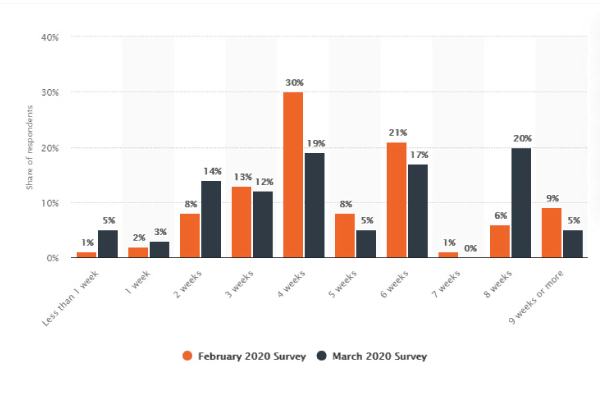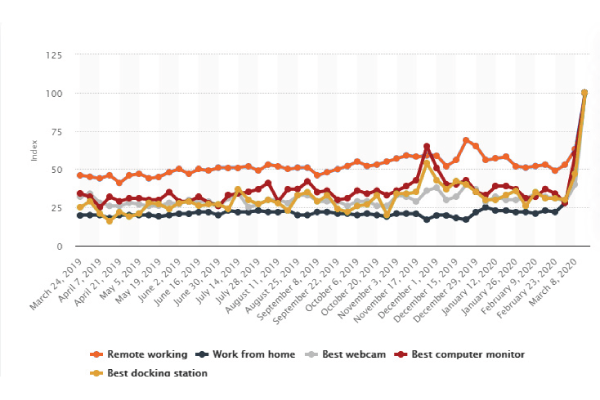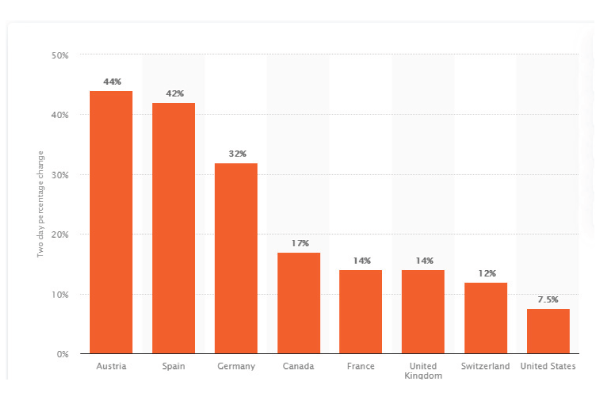With infections mounting all over the world due to COVID-19, governments and local authorities have launched increasingly stringent economic and public health responses. These responses have affected daily business operations, with most non-essential staff required to work from home as part of social distancing efforts, we are beginning to see the effects on the global economy. The technology industry is an important part of the economy, always accelerating commercial growth. As the global economy shifts to accommodate changes during this pandemic, so, too does the technology industry. This article explores how COVID-19 is affecting the tech industry.

As COVID-19 evolves daily, it is time for the tech industry to formulate actions that can mitigate the risk and prepare for how they will deal with the impacts of the coronavirus. IT experts and management should try to understand the implications of this pandemic on their companies’ business processes, and what steps they may be able to take now as preventative measures for what is to come. Innovative companies will look for ways to minimize risks associated with the virus, while making maximum gains on the new hang of things. Here is a rundown of some long-term implications of coronavirus on the tech industry.
1. A Shift in the Global Supply Chain
Tech industries rely a lot on China for the manufacture and assembly of their products. For instance, 49% of mobile phones are assembled in China. China also manufactures more than 40 times as many personal computers per person than the rest of the world, that’s 320.4 million units total. Specifically for Apple, China is the manufacturing base for more than 90% of their product lines.
China, being the epicenter of the viral outbreak, ordered a total lockdown on their industries and employees. Major players in the technology industry announced delays in product launches and slower production rates since either most of their products are fabricated in China or they rely on Chinese raw materials. Even as the government eased their stance following a drop in new cases, most factories haven’t returned to normalcy, meaning production has slowed down for most tech companies. This outbreak exposed the tech industry’s over-reliance on China, as seen in the chart below.
Figure 1: Global Electronics Supply Chain Delays in the past 2 Months. (Source: Statista.com)
While outsourcing to low-cost labor markets has been beneficial to the development of the technology industry, companies are now looking to diversify their supply chain by involving other nations in the fulfilment of their production demands. Countries like Mexico and Vietnam are already part of the global supply chain, and the spread of COVID-19 will see tech giants expanding trade relations with such nations to avoid production delays and other effects of relying on one source for material. Thanks to the spread of the Coronavirus, global supply chains will pave the way for regional supply chains such that products can be designed centrally and assembled anywhere. This will enhance the tech industry’s ability to swiftly deliver custom products sustainably and at low costs for the global market.
With the disruptions that COVID-19 has brought to the global supply chain, companies will start to leverage technologies to make the current supply chain smarter. The existing supply chain is susceptible to such events as pandemics because it relies on paper-based records, is not flexible and lacks diversity. To build a more resilient supply chain, the tech industry will look to industry 4.0 technologies such as the Internet of Things, Block chains and cloud computing. These technologies will strengthen the supply chain through data sharing, and decision-making based on more accurate data.
2. Growth in Telecommuting Technologies
The spread of the Coronavirus has accelerated the trend toward working from home. As COVID-19 keeps ravaging populations, companies are encouraging employees to work remotely and observe social distancing rules while keeping business activities ongoing. Over the last decade, telecommuting has experienced a 10% annual growth. COVID-19 is, however, a tipping point since it has demonstrated that most employees could attain high levels of productivity while working from home. The number of employees working from home has nearly doubled within the last three months as a result of the outbreak.
The COVID-19 outbreak has fostered a growth in companies that specialize in remote working technologies. Zoom Video Communications was a small online conferencing company that created solutions for telecommuting. With the advancement of the COVID-19 crisis, however, more people have downloaded its app for use in team meetings. Zoom Communications has seen an unprecedented growth in its market share, with a market capitalization of above $44 Billion. Its share price has gone up from $62 in 2019 to $160 today. Microsoft teams has recorded a 500% rise in usage since the start of the outbreak. Even as the world recovers from the pandemic, most companies will embrace remote work, which will lead to a growth in work-from-home technologies.
The chart below shows the growth in interest of remote working technologies over the past year:
Figure 2: Trend of Interest in Remote Work (Credit: Statista.com)
3. Increased Demand for Security Solutions
As more employers and employees embrace work-from-home arrangements, the cybersecurity risks involved with remote connections become apparent. There are various threats that arise from employees working remotely, and these include: data loss, denial of service attacks and corporate espionage. Most organizations have registered a surge in phishing scams, security gaps and other network security problems that result from a sudden switch to remote work. These threats create the need for practical solutions that can help secure company networks.
Security Solutions providers will benefit indirectly from the pandemic as the remote workforce grows. Organizations will boost IT spending on security as they rush to secure endpoints and employee devices. Most companies will invest heavily in log management tools, cloud-based monitoring and Virtual Private Networks in an attempt to secure their data and networks. Companies will move away from legacy solutions in favor of scalable, practical solutions that secure policy-based remote connections and cloud connections. The cybersecurity industry is expected to grow exponentially in the aftermath of the COVID-19 pandemic.
4. Enhanced Connectivity and Cloud-Based Services
As the world recovers from Coronavirus, there will be an increased need for faster access to data. With most business functions being handled remotely, there has been a 75% increase in bandwidth requirements. This increase has strained current networks, which has brought the need for deployment of stronger networks. Within companies, IT departments will enact multi-access edge computing, which will help decongest current networks.
Besides improving network device-handling capacity, this shift will also protect user data and help in real-time delivery of results. Internally, companies will adopt cloud-based network architecture to handle larger volumes of data and increase network performance. In the short-term, COVID-19 has essentially slowed down the adoption of 5G networks. The economic slowdown that accompanied the virus means that fewer resources can be directed toward network expansion.
In the long-term, telecom companies will start allocating faster broadband services to those who need it the most. This will see an increase in the deployment of 5G networks and equipment. According to Ericsson, in the next 5 years, over 50% of companies and individuals will be connected to 5G networks.

5. Growth in Specialized Services
Companies that offer specialized IT services such as e-commerce, online advertisements and social media are bound to grow in the period following the COVID-19 pandemic. These corporations have the ability to retain and hire more employees, pay taxes and contribute to economic recovery, so governments will focus on bolstering their reopening efforts.
Amazon, the world’s largest e-commerce site, will be a great beneficiary as more people will utilize its delivery and entertainment services. So far, Amazon does over twice the delivery volumes it used to make before the pandemic. Facebook, a leader in the world of social media, has reported a surge in user hours spent as more people practice social distancing. Other tech industries that will experience growth in the post-COVID-19 era include: streaming services, online learning platforms and teleconferencing solutions among others.
The graphic below illustrates the growth in time spent streaming globally between on the weekend of March 13 and 14, 2020.
Figure 3: Increase in time spent on streaming services in the two-day period (Credit: Statista.com)
6. A Shift in IT Focus Areas
As more employees work remotely, companies are beginning to appreciate the value of digital channels. To keep your firm running smoothly in the post-pandemic period, you must focus on shifting company resources and capabilities to digital platforms. IT experts and managers should develop inventory work use cases to understand the workflow of telecommuting and identify the systems required. The IT experts will also be tasked with assessing security needs while reviewing currently available infrastructure and how they affect the choice of systems and devices used in the company network.
In the coming years, companies will utilize technology to meet client demands. The CIO will come up with ways to expand self-service and digital sales capacity, which will free customer service representatives to handle more demanding tasks. It will be up to company IT experts to ensure that such services, while delivered digitally, still have an aspect of the human touch. Data centers that host company and client information will require remote management solutions, while IT budgets and resources will be realigned to accommodate the changing workforce. Intelligent IT process automation could improve productivity, reduce staff turnover and reduce operational costs if done correctly.
The New Normal
Even though the coronavirus pandemic has had undesirable effects on the economy during the period of infection, it presents exciting possibilities downstream. The virus and subsequent lockdown have enabled the hatching of new digital innovations and business models. Remote work had been on a slow rise before this outbreak. We have managed to shift to full time remote work without catastrophic failure, which shows an improvement in the digital revolution. Over 75% of employers intend to keep remote working arrangements, even intermittently, and this will spur growth and innovation in the tech industry.
The global COVID-19 outbreak has brought unprecedented economic and technological changes. We have seen a growth in demand for network security, cloud applications, delivery services, online streaming and conferencing tools for remote work. This trend is bound to continue in the post-coronavirus period. At Office1, we have technologies that enable your employees to work efficiently so we can boost your productivity while cutting costs. Talk to us about our consolidated approach to managed services so that we can ensure your IT operations contribute to business continuity in the Post-coronavirus period.
Categories: Managed Services, IT Management, COVID-19











